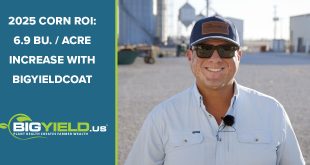My name is Dean Alexander; I am from Appleton City, Missouri, county of St. Clair. I farm 5,000 acres of corns, beans and wheat. I learned about John last year. I was out of Conkland Pro Ag training seminar, and they were using his name with Kip Culler and some very good, very good researchers and agronomists. I was like “Well, he’s close by. I’ll stop by and see him and visit with him.” And I came by one day, and he took me around and showed me some of the things that he was doing. I was very very impressed with the time he took on all the research that he did and the things he was trying; I mean he was completely doing things that I had never heard of.
I have been kind of contemplating what starter fertilizer with my corn, and have always used kind of foliars and fungicides with my beans. John got me on a program this year with a 3-18-18 BP Foliar and ballad, biological fungicide, In-Furrow on my corn at four gallons an acre.
I knew I needed to do it because over the last few years they have been talking about starters and cover crops and the big thing in Ag has been GPS and guidance. I knew I needed to make a move to do a better job to try and increase my yield. I tried it. I spoke with John. We went over a lot of things, and we put on four gallons an acre. We did it on every bed of our corn. I did a few check strips so that I could go back and see the difference that it made, and I was just absolutely blown away by the results that I saw.
I had planted next to a guy. We’re in the same field, the same evening, and a rain was coming. We knew it. We only had about three days to plant. He planted, I planted, we both pulled out, and I said this is going to be a good comparison. I mean, I’m going to have start up In-Furrow here, and he’s not going to have anything. My corn was out of the ground four days quicker than his was, and we had gotten a big rain. We had gotten a three inch rain, and that usually never works in Missouri when you get a big rain.
You know, that corn just took off. It just jumped right out of the ground. His stalks at probably about two weeks were, oh, probably about the size of my pinky. My stocks were, I mean, they were three times bigger, the brace roots already set, and I said this, “If anything else fails, this is the best thing that’s happened, because it saved my stand” you know? And we were behind on our planting date anyway. So, you know, just watching it grow it’s had a lot more vigor, and I am really anxious to see, you know, what my yields are compared to my check strips. I am looking at the years that I pull of and the years that I use my starter In-Furrow program. It looks to me like I am going to have thirty to forty bushel increase in my yield, no doubt.
As far as the value of the product some people, well, they are going to kind of cringe to get their planter set up on liquid fertilizer which is going to cost somewhere, you know, ten thousand dollars. At forty dollars an acre I think I am going to see a thirty-five to forty bushel yield bump. At five dollars corn I’m spending forty dollars an acre in my startup program, and you know even forty bushel at five dollars, two hundred dollars an acre, you know, that is one hundred sixty dollars of extra revenue per acre by using the startup program.
 BigYield High Yield Soybeans, High Yield Corn, and High Yield Wheat
BigYield High Yield Soybeans, High Yield Corn, and High Yield Wheat



